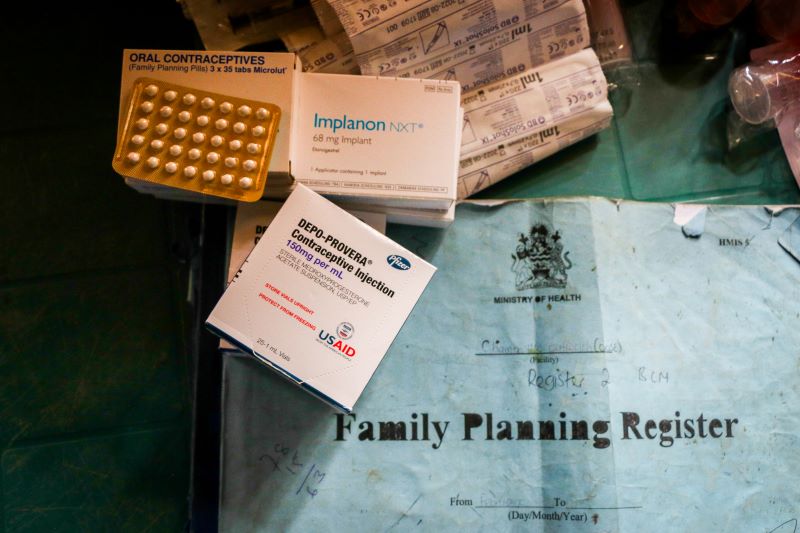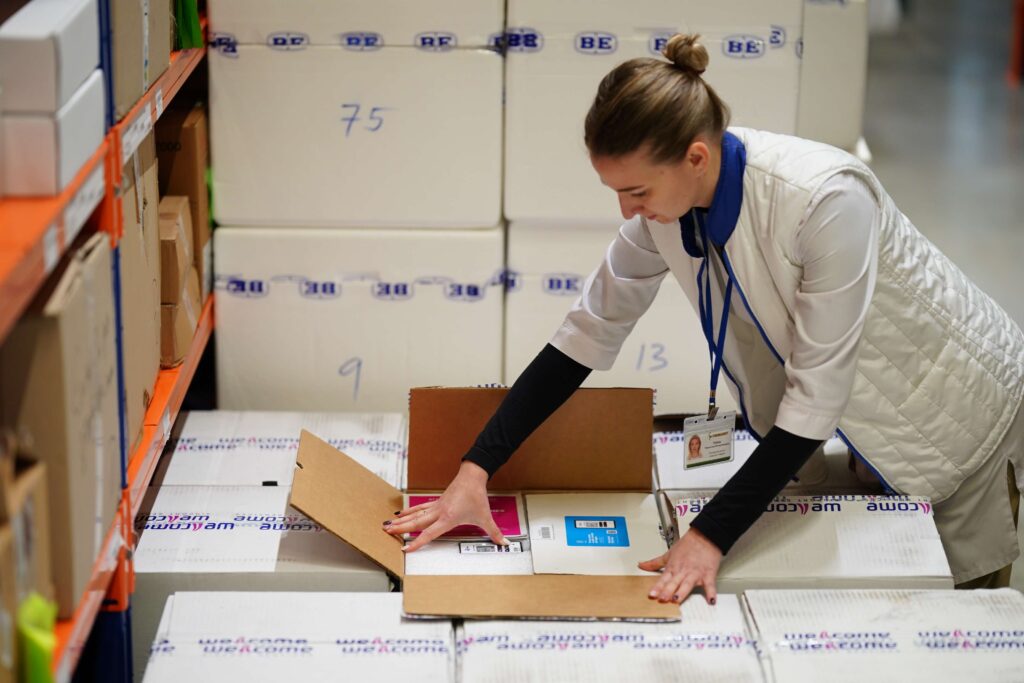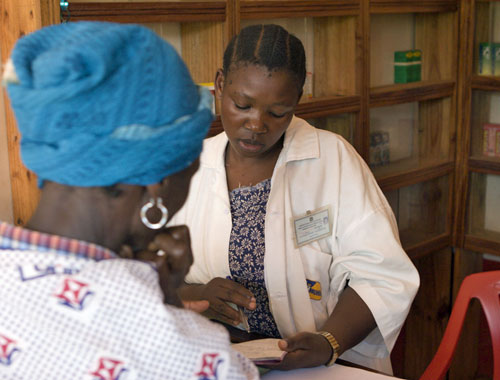A New Focus for Increasing Access to Sexual and Reproductive Health Products in Africa
A New Focus for Increasing Access to Sexual and Reproductive Health Products in Africa
By Marian W. Wentworth, MSH President and CEO

Whether it’s a family planning tool, treatment for a sexually transmitted infection, or an injection to stop a new mother from hemorrhaging after childbirth, sexual and reproductive health (SRH) products are vitally important in the modern world. They can save lives, cure or prevent disease, protect children, and allow people—particularly women and girls—to make informed choices about their sexual and reproductive wellbeing.
But these products are out of reach for far too many people, especially in sub-Saharan Africa, where more than half of all maternal deaths occur. The barriers hindering access to safe, affordable, and quality-assured SRH products are many, and they often stem from three primary factors: inadequate financing, inconsistent distribution, and ineffective regulation. Addressing such diverse problems requires an equally varied set of solutions, many of which will need to be implemented over the long term.
Governments don’t have to reinvent the wheel, however. Many strategies that have already been proven in other contexts can be tweaked and repurposed to address barriers to accessing SRH products. Governments also don’t have to do it all alone. They can take advantage of existing resources by working to shore up the private sector—an asset donors historically have not prioritized, particularly with respect to business-to-business commercial activities.
Keeping costs down
Financing for SRH commodities in Africa currently relies heavily on donor funding. For example, 100% of the contraceptives individuals obtained through the public health systems in countries such as Zimbabwe, Tanzania, South Sudan, and Sierra Leone in 2021 came from in-kind donations.
![[SCMS procures more than 70% of the ARVs for the more than 5.7 million patients on antiretroviral treatment directly supported by PEPFAR. The project helped reduce the cost of drugs for treating a single patient to $110 per year.] {Photo credit: Robyn Lesley/SCMS}](https://msh.org/wp-content/uploads/2016/05/south_africa1_credit_robyn_lesley_highres_0.jpg)
Donor funding is vulnerable and cannot be expected to last forever, though, and national budgets are not catching up quickly enough to meet growing demand. Product supply costs are expected to rise by USD 360 million in low- and middle-income countries (LMICs) over the next decade, according to the Shaping Equitable Market Access for Reproductive Health (SEMA Reproductive Health) initiative. Governments therefore must come up with cost-saving strategies so they can afford the price of procurement.
Planning is key to keeping costs down in general, but planning for SRH expenditures is difficult for countries that don’t have ready access to timely and accurate data to guide their decision-making.
To help address that shortcoming, MSH has developed a primary health care (PHC) costing, analysis, and planning tool that allows users to estimate both the amount currently being spent on PHC services and the cost of providing those services at different coverage levels. The tool can be used to estimate the financial gap in the resources needed to achieve universal coverage of primary health services and products, including SRH commodities.
Health technology assessment (HTA), a process that guides governments in determining where their limited health care funds should be spent, can also help with planning.
HTA takes a systematic approach to priority setting by determining the value of a drug, diagnostic test, or medical device or procedure at different points in its lifecycle, considering factors such as equity, ethics, justice, and societal impact. MSH, through its work on the USAID Medicines, Technologies, and Pharmaceutical Services Program, has developed a roadmap to help LMICs make evidence-based decisions on whether, when, and how to develop their own HTA.
Guarding against stockouts
![[A pharmacist dispenses medicines to a patient at Arua Regional Referral Hospital.] {Photo credit: UHSC/MSH staff}](https://msh.org/wp-content/uploads/2020/07/dsc_0448_pharmacy_staff_at_arua_regional_referral_hospital_photo_credit_msh_715px_0.png)
A lack of accurate, real-time data also can result in supply chain issues that, in turn, can cause stockouts of SRH products.
Research by the Stop Stockouts Project found that 40% of all medicine stockouts in the public health care system in South Africa between April and June 2022 were of contraceptives. While the project acknowledged that the underlying causes of those specific shortages remain unclear, it noted that supply chain bottlenecks in general “contribute significantly to persistent high stockout rates.”
When addressing those bottlenecks, governments can learn from the experience of Uganda, which, with the help of MSH, is working to completely digitize its supply chain to provide end-to-end visibility of essential medicines and health commodities across all facilities and warehouses. Paper-based manual and fragmented electronic supply chain processes are being replaced with an integrated system that can be used to place and track orders from the central medical warehouse and through which the government can access the information it needs to make strategic decisions and form effective policies.
Ukraine similarly is tackling supply chain issues head-on. With the support of MSH and the USAID Safe, Affordable, and Effective Medicines (SAFEMed) for Ukrainians Activity, the country’s government entered into a public-private partnership with logistics services company Farmasoft to facilitate last-mile delivery of certain critical medicines.

That partnership was initially aimed at implementing a systematic approach to distributing HIV medications to subregional health care facilities. But its success at that—and subsequently at distributing TB drugs, COVID-19 vaccines, and humanitarian aid in the wake of the Russian invasion of Ukraine—makes it a model well-suited for replication in other parts of the world and for other commodities, including SRH products.
Supply chain isn’t the only issue
Leveraging the private sector in other ways can be valuable, too.
Governments of LMICs can help lower the costs of SRH products by procuring them through a group purchasing organization such as MedSource. Launched by MSH in Kenya in 2017, MedSource helps its members—pharmacies, hospitals, clinical laboratories, and other health care providers in the private and public sectors—realize savings and efficiencies by aggregating purchases and using that combined buying power to negotiate discounts with manufacturers, wholesalers, distributers, and other vendors.
Another option is for governments to set up their own pooling arrangements, which can start as simple information sharing about sellers and products and progress to centralized contracting and purchasing. South Africa’s experience with pooled procurement of antiretrovirals for HIV illustrates the benefits buyers can reap from the mechanism: the country has cut the price of life-saving HIV treatments by 68% since 2011 by combining the buying power of its nine provinces.
Strengthening the capacity of private-sector retailers also has a role to play, given that between 43% and 62% of the costs of SRH products in LMICs are paid out of pocket, according to SEMA Reproductive Health. One way to do that is to nurture the development and expansion of programs like the Accredited Drug Dispensing Outlet (ADDO) initiative.
Many people in low-income and rural areas without easy access to traditional pharmacies get their medications and health supplies from small private drug shops that are not authorized to sell prescription products yet do so anyway. But rather than reining in those illegal activities by shutting the shops down, the Tanzanian government teamed up with MSH to establish the ADDO program, which trains shop employees on drug dispensing best practices and authorizes those vendors that meet certain minimum criteria to sell prescription medications and devices.

Since the ADDO initiative was launched in 2003, other African countries, including Uganda, Liberia, and Nigeria, have implemented regulation and training programs for informal medicine shops. And the approach has spread to other continents as well; MSH is currently working with the government of Bangladesh to establish a similar certification program in that country.
Strong and efficient regulation is important not just for drug shops but also for the medical products they sell. That is why MSH developed, and is working with countries to implement, tools such as the Pharmacovigilance Monitoring System (PViMS) and Pharmadex, which help governments track adverse drug events and medicines registration, respectively.
MSH also supports the establishment of the African Medicines Agency (AMA), which aims to harmonize the regulation of medicines and medical products among African Union (AU) member states and ultimately lay the foundation for a single African regulatory agency. The treaty establishing the AMA went into force in November 2021 when it hit the required threshold of ratification by 15 AU member states. In July 2022, Rwanda was selected to host the AMA’s headquarters.
In strengthening regulation across the continent, the AMA hopes to improve patients’ access to quality, safe, and efficacious medicines and health technologies by, for instance, streamlining the process for bringing new products to the market and stemming the flow of counterfeit and substandard drugs.
Establishing the AMA would also help in the ongoing push to bring local manufacturing of quality-assured products to Africa.
Although the vast majority of African countries have some pharmaceutical production capability, its growth is hampered by several issues, including underdeveloped regulatory frameworks and inadequate regulatory capacity. The AMA could supply the missing pieces that would enable those countries to manufacture SRH commodities and other medical drugs and products that would be recognized world-wide as meeting specific standards for safety and effectiveness.
MSH recently teamed up with Unitaid and other industry leaders on an opinion paper that, among other things, explores the coordination and collaboration needed to establish the regulatory structure and other foundational elements necessary to place local manufacturing of quality-assured health products on the right trajectory in Africa.
Looking to the future
Overall, increased advocacy and capacity strengthening, an MSH specialty, are essential for helping governments and the private sector meet the demands of a growing population.
The world is changing, and the only way to keep up—or, ideally, get ahead—is to change with it. Supporting local leadership, building better systems, and working to understand people’s evolving SRH needs are crucial for ensuring reliable and affordable access to quality medical products for all and allowing vulnerable women and girls, in particular, to take charge of their sexual and reproductive lives and, consequently, their future.